What physical property of minerals is commonly tested by scratching with various materials?
A) Cleavage
B) Luster
C) Hardness
D) Color
What is C) Hardness
John is examining a mineral and observes that it reflects light in a metallic manner. What mineral property is John most likely describing?
A) Color
B) Hardness
C) State of matter
D) Luster
What is D) Luster
Define Luster
Luster is the overall sheen of its surface – it may have the sheen of polished metal, or that of an unpolished metal that is pitted by weathering – or it may have the sheen of glass, or look dull or earthy, etc.
Metallic and non metallic
The color made when the mineral is rubbed against a hard surface is called?
What is a Streak
In a geological expedition, scientists find a mineral with a unique rainbow-like color. They are excited to identify it using the color test. However, when scratched on a streak plate, the mineral leaves a black streak. What does this scenario suggest about the reliability of the color test?
a. Color is reliable, and the mineral is rare and valuable.
b. Color is not reliable, and the mineral's streak may be influenced by impurities.
c. Color is reliable, and the mineral is likely graphite.
d. Color is not reliable, and the mineral's surface color is misleading
What is b. Color is not reliable, and the mineral's streak may be influenced by impurities.
Why is the hardness test valuable in mineral identification?
A) It determines the mineral's color.
B) It reveals the mineral's chemical composition.
C) It provides information about the mineral's resistance to scratching.
D) It assesses the mineral's specific gravity.
Use the Mohs Hardness Scale below to answer questions 3 and 4.
A mineral is identified as having a hardness greater than that of quartz but less than that of diamond. What is the estimated hardness range of this mineral?
A) 1-2 mohs
B) 3-4 mohs
C) 5-6 mohs
D) 8-9 mohs
What is D) 8-9 mohs
The mineral quartz naturally forms in various colors. What is most likely the cause of a mineral having different colors?
A) different hardness levels for each color
B) different lusters of each color
C) chemical impurities or slight imperfections the mineral contains
D) scratches on the surface caused by other minerals
C) chemical impurities or slight imperfections the mineral contains
Why is luster considered an important property in mineral identification?
a. It determines the mineral's weight.
b. It provides information about the mineral's surface shine.
c. It influences the mineral's color.
d. It indicates the mineral's transparency
What is b. It provides information about the mineral's surface shine.
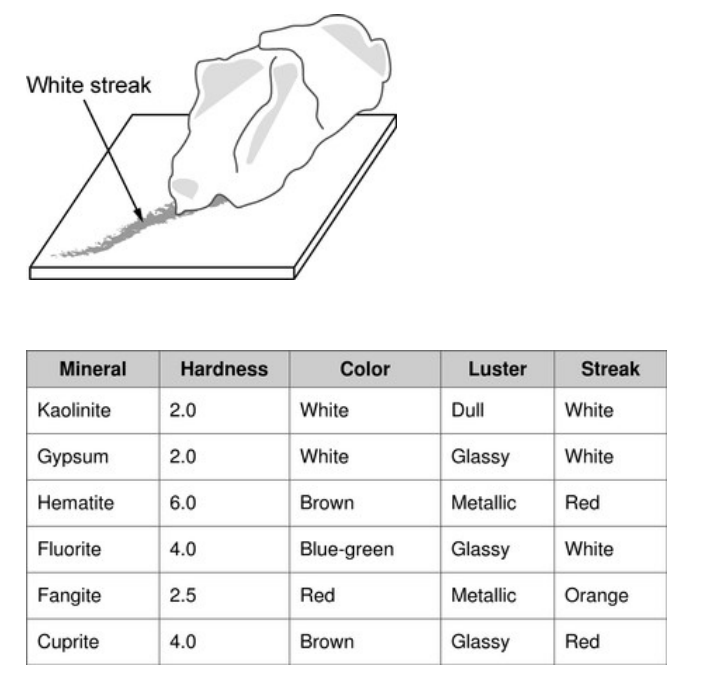 An unknown mineral does NOT scratch fangite and has a glassy luster. Using the illustration and data table, which of the following is the unknown mineral?
An unknown mineral does NOT scratch fangite and has a glassy luster. Using the illustration and data table, which of the following is the unknown mineral?
A. Kaolinite
B. Fangite
C. Gypsum
D. Fluorite
What is C. Gypsum
A geologist is analyzing an unknown sample in a lab. He performs a series of tests and gets mixed results. One portion of the sample streaks red, while another streaks white. Some portions of the sample have a glassy luster while other portions have a dull luster. Based on these results, the geologist determines the sample contains five different materials. According to the tests performed by the geologist and the geologist's determination, the sample is most likely — A.
A pure mineral.
B. a rock.
C. an element.
D. a pure crystal.
What is B. a rock.
A mineralogist is conducting a field study and encounters a mineral that can be scratched with glass but not scratched with a penny. What is most likely the identity of this mineral?
A) Gypsum
B) Quartz
C) Corundum
D) Apatite
What is D) Apatite
Mark is comparing the luster of two minerals. One mineral reflects light in a way that resembles the surface of a pearl, while the other mineral reflects light like a shiny metal. What terms describe the luster of these minerals, respectively?
A) Pearly and Metallic
B) Glassy and Earthy
C) Silky and Waxy
D) Vitreous and Dull
What is A) Pearly and Metallic
How does the property of luster contribute to the identification of minerals?
a. It indicates the mineral's weight.
b. It provides information about the mineral's surface shine.
c. It influences the mineral's color.
d. It determines the mineral's transparency
What is b. It provides information about the mineral's surface shine.
What challenges might arise when relying solely on color for mineral characterization?
a. Different minerals have the same color.
b. Color is always reliable.
c. Color is not important in mineral identification.
d. Color is the only property needed for identification
What is A. Different minerals have the same color.

. A student is experimenting with a mineral sample believed to be fangite. However, the student's test results show very different physical properties from fangite. The sample had a glassy luster, streaked red, and could scratch fangite. Using the data table, What is the true identity of the sample?
A. Fluorite
B. Kaolinite
C. Hematite
D. Cuprite
What is D. Cuprite
Why is the hardness test valuable in mineral identification?
A) It determines the mineral's color.
B) It reveals the mineral's chemical composition.
C) It provides information about the mineral's resistance to scratching.
D) It assesses the mineral's specific gravity.
C) It provides information about the mineral's resistance to scratching.
A student in a science lab is examining an unknown mineral. The student determines that the unknown mineral has a glassy luster and is not harder than apatite. Using the table below, which of the following could be the unknown mineral?
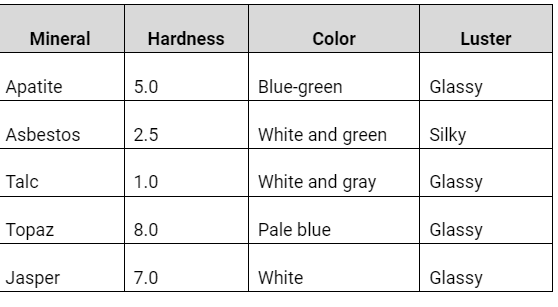
A) Topaz
B) Talc
C) Asbestos
D) Jasper
What is B) Talc
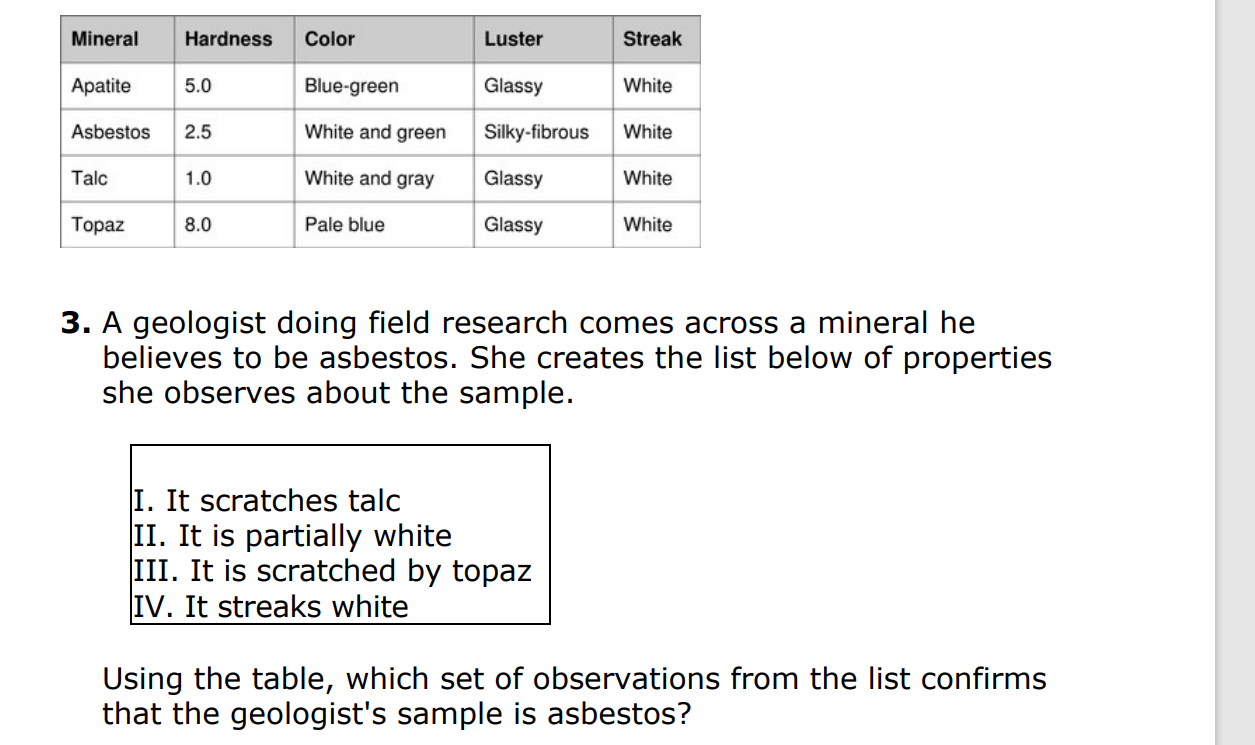
A. II and III, only
B. II, III, and IV, only
C. I, III, and IV, only
D. I and II, only
What is D. I and II, only
The picture below shows a rock with large amounts of the mineral copper in it. Copper has reddish color and is often used in wires.
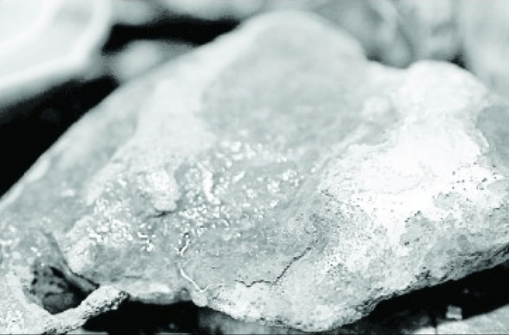 Which of the following is a property of copper?
Which of the following is a property of copper?
A. It is a soft mineral and a good conductor.
B. It is a hard mineral and a poor conductor.
C. It is a hard mineral and is translucent.
D. It is a soft mineral and has no luster.
What is A. It is a soft mineral and a good conductor.
In a mineralogy workshop, students are given two minerals with identical red coloration. They are tasked with identifying the minerals using only color. After careful observation, they realize that both minerals exhibit different lusters - one is metallic, and the other is dull. What challenge does this scenario highlight when relying solely on color for mineral identification?
a. Color is always a reliable indicator.
b. Different minerals can have the same color.
c. Metallic luster is always associated with a specific color.
d. Dull luster is unrelated to the mineral's color.
What is b. Different minerals can have the same color.
How does understanding the hardness of minerals contribute to their identification and classification in geology? Provide examples or scenarios where hardness testing is particularly valuable in mineral analysis.
What is hardness ?
How is hardness determined ?
What is the Mohs scale
What is the hardest mineral ? what is the softest mineral ?
Testing the physical properties of minerals, such as hardness, is crucial in geology as it aids in mineral identification and classification. Hardness testing, often measured on the Mohs Scale, helps differentiate minerals, as each mineral has a unique hardness level. The Mohs Scale is a qualitative ordinal scale that characterizes the scratch resistance of various minerals through the ability of a harder material to scratch a softer material.
Explain the significance of testing the physical properties of minerals, with a particular focus on color and luster. How do these properties contribute to the identification and classification of minerals, and what challenges might arise when relying solely on color or luster for mineral characterization?
What is the color Test ?
Is color a good identifier? explain your answer.
What is the Luster test ?
Testing the physical properties of minerals, particularly color and luster, is vital for accurate mineral identification. While color provides initial clues, it can be deceptive due to impurities. Luster, indicating how a mineral reflects light, offers insights into composition. However, challenges arise, such as variations within a type of mineral and the influence of impurities. A comprehensive approach, considering additional properties like hardness and cleavage, is essential for precise mineral characterization.
A geologist is examining an unknown mineral. She notes a glassy luster and pale blue color. Which mineral from the table could be the unknown mineral? Justify your answer.
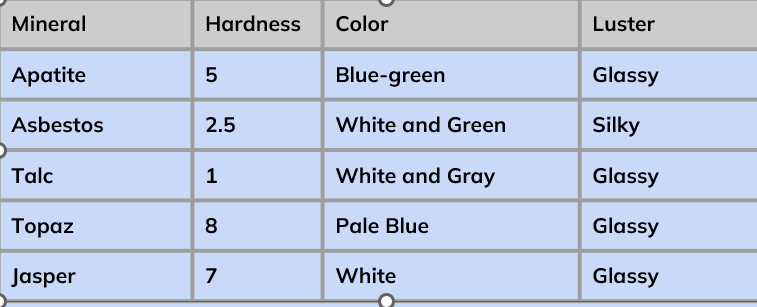
A) Apatite
B) Talc
C) Topaz
D) Jasper
What is C) Topaz
How do you find the streak of a mineral?
To determine the streak of a mineral , rub the mineral across a piece of unglazed porcelain known as a streak plate
Why is color in some cases a reliable and in some cases a non-reliable test for identifying minerals?
Color is often a double-edged sword in mineral identification: There are many minerals which have distinctive colors, but there are also many which come in a variety of hues. Color, in general, should never be taken as diagnostic by itself.